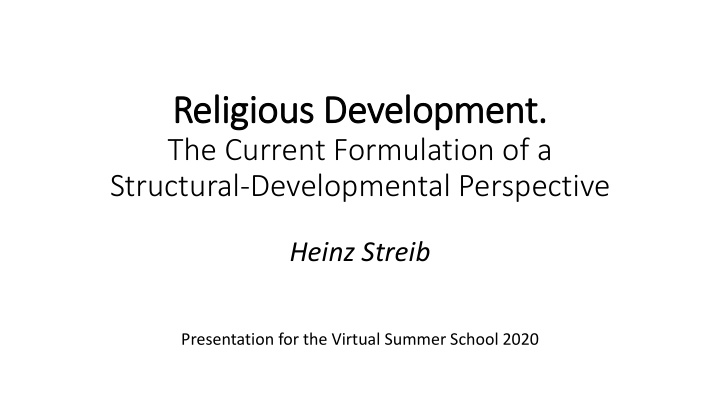



Religious D Devel elop opmen ent. The Current Formulation of a Structural-Developmental Perspective Heinz Streib Presentation for the Virtual Summer School 2020
Religious Development. The Current Formulation of a Structural-Developmental Perspective 1. 1. The Q e Ques esti tion
Ex Examples Person A passionately claims the exclusive validity of their religion and the authoritativeness of their religious prescriptions also for anyone else. Person B shows intellectual humility and is open for encountering the unknown and supports inter-religious dialog. Person C , based on their own autonomous reflection, attempts to promote rationality, and suggests fair coexistence and tolerance. Person D is deeply embedded in their religious community and wants to preserve harmony and avoid any conflict.
2. Proposals f for Structural al D Differ eren ences es
2.1 A 1 Allport’s P s Proposal for S Struc uctural Di Differ eren ences Allport’s (1950, 1966; Allport & Ross, 1967) distinction between two types of religion, intrinsic and extrinsic: - “the extrinsic religious orientation is … the context of prejudice,” - “the intrinsic orientation is the matrix of tolerance” (Allport, 1966, p. 455) Important is the contrast between a version of religion that supports prejudice and a version of religion that promotes tolerance—which, as Allport (1954, p. 456) has also put it, is the contrast between - the religion “of an ethnocentric order” and - the religion “of a universalistic order.”
2. 2.2 T The P Post-criti tical Belief M Model The Post-critical belief model and the Post-critical Belief Scale attend to differences between four types: 1. orthodoxy 2. external critique 3. relativism, and 4. second naïveté. Developmental order? (Hutsebaut, 2000) For the figure,see Fontaine, J. R. J., Duriez, B., Luyten, P., & Hutsebaut, D. (2003). The internal (PCBS; Duriez, Soenens, & Hutsebaut, 2005; Hutsebaut, 1996; Hutsebaut, 2000) structure of the Post-Critical Belief Scale. Personality & Individual Differences, 35 , 501-518.
2.3 3 Fowler er’s P s Proposa sal f for S Structural Di Differ eren ences es
Fowler, J. W. (1981): Stages of Faith, San Francisco: Harper & Row.
Fowler‘s ‘s Defini nition n of of ‚fa faith‘ 198 1981 “In the most formal and comprehensive terms I can state it, faith is: People’s evolved and evolving ways of experiencing self, others and world (as they construct them) as related to and affected by the ultimate conditions of existence (as they construct them) and shaping their lives’ purposes and meanings, trusts and loyalties, in the light of the character of being, value and power determining the ultimate conditions of existence (as grasped in their operative images - conscious and unconscious - of them).” Fowler, J. W. (1981): Stages of Faith, San Francisco: Harper & Row, p. 92-93.
What at is is a a stage ge? ? What at is is dev evel elopmen ent of of fa faith? In his characterzation of faith stage development, Fower generally followed Kohlberg‘s criteria for („hard“) cognitive-structural stages: • Structural Difference • Structural Wholeness • Invariant Sequence & Irreversibility • Hierarchical Integration • Universality Kohlberg, L., Levine, C. & Hewer, A.. (1983). "The Current Formulation of the Theory", in: L.Kohlberg: Essays on Moral Development, Vol.II. The Psychology of Moral Development , (pp. 212-319) San Francisco: Harper & Row 1984; quote: p. 238.
Nec ecessa essary Revis visio ions of of Faith D h Dev evel elopm pmen ent T Theory… … regarding the ‘logic’ of stage development: Yes, we agree! • Structural Difference • Structural whole … are not empirically supported: • Abandoment of previous styles need to be rejected • Irreversibility • Invariance } ? …depend on empirical evidence • Sequentiality • Universality …derives strong support from philosophy, • Hierarchy rather than from psychology alone 11
3. The R he Religious S s Styles M es Model del – Our P Proposal f for S Structural D Differences
Conceptua ual a l and M nd Methodolo logic ical Decisio ions ns … …
Five Religious Styles – Recent Characterizations Openness for dialog and for being challenged or changed by the encounter with the Other/the Strange; xenosophia Critical and autonomous reflection; in case of conflicting validity claims, models of tolerance are considered. Consent to conventions of one’s group or life-world; mutual interpersonal and uncritical harmony Mythic-literal and ethnocentric insistence on the truth of text and teachings of one’s own tradition; system of punishment and reward. Subjective orientation without an awareness of the interiority of the other; dependence on the external authority of others/caretakers
4. 4. Conlcusion on
How w w we take Fowl wler’s l s legac acy f y further… r… 1. Differential conceptualization of religion : a) Variety of structurally different religious styles b) Change and development over time 2. Using the Faith Development Interview (FDI) a) Triangulation with questionnaire data b) Combination of ideographic and nomothetic perspectives. 3. Potentials for longitudinal research on religious change and development: a) Re-Interviewing with the FDI after some years b) Construction of religious types c) Longitudinal modeling of styles, types, and scales—still combining ideographic and nomothetic perspectives.
What is religious development? A A Str tructu tural D Defi finition Religious development consists in changes in an individual’s lifetime. These changes are characterized by intra-individual differences between structurally distinct ways of understanding, appropriating and re-constructing the propositional, narrative, symbolic and ritual manifestations that religious cultures offer, and individuals use, for making meaning of their everyday and extraordinary experiences. When such structurally distinct ways of meaning-making that change in an individual’s lifetime are regarded to present a hierarchical order, we speak of religious development. Structural models require an open conceptualization of (‘religion’ as) ‘meaning-making’.
Recommend
More recommend